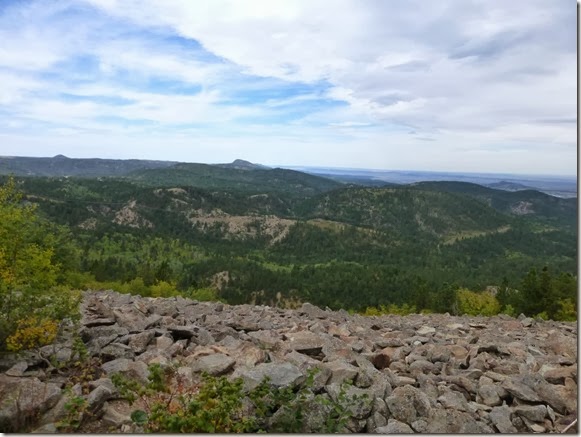According to the Center, “The times of "fabulous fortunes" were sensational, wild, perhaps wicked and short lived. The actual Deadwood/Lead gold rush began in 1875 and ended in 1877. Yet, gold was to play a huge role in the area’s history, economy, and development for many, many years to come.”
Near the end of the Black Hills gold rush, George Hearst purchased one of the claims in the area and incorporated it as the Homestake Mining Company which operated for 126 years – until 2002. Homestake was the oldest, largest and deepest mine in the Western Hemisphere, reaching more than 8000 feet below the town of Lead. Mining operations included both underground and surface operations. The historic 1876 open cut mining area was amazing to see.

We also stopped at the Interpretative Trail to see part of the original equipment used in the mining operation.

From Lead, we headed a few miles past Deadwood to hike up Mt. Roosevelt, upon the recommendation of the visitors’ center. The hike was an easy one – only about two miles round trip and not very strenuous, but the views were amazing!

We could see to Spearfish and Belle Fourche, plus the Bear Lodge Mountains in Wyoming, and views of the plains all the way to North Dakota. From other parts of the trail we could see Bear Butte, Terry Peak, Custer Peak, Harney Peak and the cities of Lead, the Homestake Open Pit Mine, and Deadwood.
In 1919 Deadwood’s sheriff, Seth Bullock, built the Mount Roosevelt Friendship Tower in dedication to his close friendship to President Theodore Roosevelt. It was also meant to be a memorial of both Bullock and Roosevelt’s love of the wide open spaces they both loved. We climbed to the top of the 31 foot tower which now has a roof covering the overlook platform. The views were stunning!


We continued back down the trail and got a good view of Bear Butte to the east, as well as several rock fields.


Back in Deadwood, we stopped at the Adams Museum which, in 1930, was a gift to the City of Deadwood. Deadwood businessman and former mayor W.E. Adams built the Adams Museum as a tribute to Black Hills pioneers and in memory of his deceased first wife and two daughters.The museum houses an incredible collection of artifacts and memorabilia from powerful legends of Wild Bill, Calamity Jane and Deadwood Dick. There is also a large collection of Lakota bead and quill work and Potato Creek Johnny’s gold nugget.



The guys participated in a friendly poker tournament in the afternoon while Ann and I relaxed and read back at the RVs.
The weather changed – again – later in the evening. Rain began about 9 pm and continued ALL night into Monday.
We had intended to get an early start and go to Devil’s Tower on our drive home, but the forecast was more rain, so we packed up and headed back to Colorado. The fog and clouds hung low and made for a sloppy drive.

After noon the sky started to clear as we were heading south through Wyoming.

By the time we arrived back in Fort Collins the sun was shining and the sky was clear. It was a fun trip, but it’s good to be home!




The guys participated in a friendly poker tournament in the afternoon while Ann and I relaxed and read back at the RVs.
The weather changed – again – later in the evening. Rain began about 9 pm and continued ALL night into Monday.
We had intended to get an early start and go to Devil’s Tower on our drive home, but the forecast was more rain, so we packed up and headed back to Colorado. The fog and clouds hung low and made for a sloppy drive.

After noon the sky started to clear as we were heading south through Wyoming.

By the time we arrived back in Fort Collins the sun was shining and the sky was clear. It was a fun trip, but it’s good to be home!










































